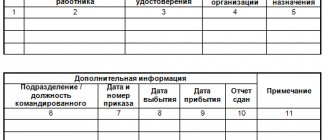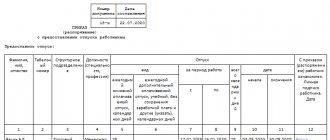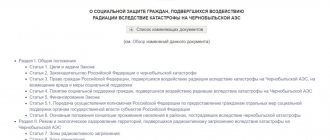Selection of the most important documents upon request Storage period for vacation orders
(regulatory legal acts, forms, articles, expert consultations and much more).
Regulatory acts. Storage period for vacation orders
Order of the Ministry of Culture of Russia dated 08/25/2010 N 558 (as amended on 02/16/2016) “On approval of the “List of standard management archival documents generated in the process of activities of state bodies, local governments and organizations, indicating storage periods” (Registered with the Ministry of Justice of Russia 09/08/2010 N 18380) b) on personnel (reception, transfer, combination, transfer, dismissal; certification, advanced training, assignment of titles (ranks); change of surname; incentives, awards; wages, bonuses, various payments; all types vacations for workers with difficult, harmful and dangerous working conditions, maternity leave, leave without pay (salary); duty on duty in the main activity; long-term domestic and foreign business trips, business trips for workers with difficult, harmful and dangerous working conditions)
Articles, comments, answers to questions. Storage period for vacation orders
Article: Archive of the organization: we store documents on labor and wage accounting (Demidov G.I.) (“Payment: accounting and taxation”, 2020, N 11) Orders, instructions, documents (certificates, summaries, information, reports) on personnel relating to:
The document is available: in the commercial version of ConsultantPlus
Article: Examination of the value of documents in the company and in the personnel department (Kozhanova E.) (“HR service and personnel management of the enterprise,” 2020, N 12) Note. For more information about the latest changes in the duration of storage of documents on personnel, read the article “Storage periods for documents on personnel” on p. 48 magazine N 5, 2020.
The document is available: in the commercial version of ConsultantPlus
Orders for personnel - their formation and storage
Orders for personnel are grouped into a separate file, and have their own numbering (different from orders for main activities). Within the file, documents are systematized according to the chronology of their creation.
Some types of orders for personnel are usually issued in a unified form. In this case, you just need to fill in the appropriate fields. The rest are compiled in free form, but at the same time it is necessary to adhere to certain requirements. If an order is drawn up in a non-unified form, the same recommendations are applied as for drawing up an order for the main activity.
Stage 4 Registration of a personal employee card
Information about the granted study leave is entered into the employee’s personal card.
This section contains the following information:
Since study leave is not granted for the working year, the corresponding columns of the employee’s personal card table are not filled out.
https://youtu.be/G0k6AIkVUPs
Formation of orders for personnel
Orders on personnel should be grouped into files based on their storage periods; however, it is not allowed to place documents of long-term storage (i.e. > 10 years) and temporary periods < 10 years together (in one file). For example, orders for admission, dismissal, etc. with a storage period of 75 years should be placed separately from orders for annual leave and business trips, which are stored for 5 years.
In this case, orders with the same storage period are allowed to be further divided into separate cases to facilitate their search in the future (especially with a large document flow). For example, orders on annual leave may constitute a separate file, and orders on business trips – another, although they all have a five-year retention period.
I would like to remind you once again that each independent matter must be included in the organization’s list of affairs.
If there is an appendix to an order, they are formed together - first the order, then the appendix.
At the same time, the grounds for orders regarding personnel are placed separately from them. The basis for orders may be:
As a rule, if in the current office work orders and the grounds for them were jointly formed, then in the process of preparation for archival storage such cases are reorganized to separate them. The grounds for orders with a shelf life of 75 years (for example, an employee’s application for admission, relocation, etc.) are usually included in the employee’s corresponding personal file.
The grounds for orders with short storage periods (for example, 5 years) can be formed separately from them, for which the nomenclature can include a case with an approximate title: “Documents that are not included in personal files (and their main types must be listed in brackets) "
When forming cases, it is necessary to check the correctness of registration: the presence of a signature, visas, date and order number. Unfinished orders are not allowed to be filed into files.
Maintaining personal files of employees in 2020: basic rules
The creation of personal files is usually entrusted to a personnel officer or clerk. Since the information that you have to use in the process of work is personal in nature, strictly follow the requirements for the protection of personal data! The procedure for registering personal files is fixed at the local level - by order, regulation, special instruction or regulation. Additionally, the employer establishes a list of documents included in the personal file, which usually includes:
- internal inventory of personal files;
- questionnaires, tests, autobiography, job application and other documents received from the employee at the interview stage;
- copies of diplomas, certificates, licenses and other documents on education, qualifications, special skills and knowledge;
- employment contract and additional agreements thereto;
- copies of passport, TIN, insurance certificate;
- certification sheets and reviews of colleagues about the employee;
- characteristics and letters of recommendation;
- reports and memos;
- job descriptions;
- acts and notifications;
- personal statements and health certificates;
- copies of personnel orders related to the employee - on transfers, incentives, long-term business trips, assignments for training, application and removal of disciplinary sanctions;
- personal sheet (card) for personnel records.
This is important to know: Order on early release from parental leave for a child under 3 years of age (sample)
In general, the composition of a personal file is determined by the characteristics of the relationship with a specific employee and the nature of the work assigned to him. For example, an agreement on non-disclosure of confidential data is filed in a folder for an employee who has access to a commercial or other secret protected by law. And in the file of a working disabled person, copies of documents establishing disability and limited ability to work are kept.
The legislator has not unified the form of a personal file. Consequently, each organization has the right to independently decide what such a folder should look like and what documents should be filed in it. As a rule, it is based on a personal sheet (card) for personnel records, containing personal and biographical information about the employee (date of birth, full name, gender, marital status, profession, level of foreign language proficiency, etc.). This can be either a unified T-2 form or a form developed by the employer.
It is filled out by the employee himself after employment, confirming the accuracy of the information provided with a signature indicating the date. A photo is also pasted here. To update information (for example, in the event of a change in marital status, obtaining an academic title or increasing the qualification level), an addition is drawn up.
Read about the rules for working with unified T-2 forms on the Personnel Affairs portal:
- Personal employee card in form No. T-2: registration procedure
- Simple secrets of a personal card
- Storage period for personal T-2 cards
The generated personal file is kept in the HR department until the employee is dismissed. Access to folders is strictly limited. After the termination of the employment relationship, no later than three years from the date of dismissal, the case is transferred to the archives. Even before transfer, a certification sheet is placed at the very end of the folder indicating the number of sheets, the characteristics of the physical condition and formation of the volume, the date of registration and the signature of the responsible official.
To help the HR manager - a useful video on how to put local documentation in order and approve missing forms for comfortable work on personnel records, and a selection of ready-made HR documents for downloading:
- Questionnaire from the employee’s personal file
- Cover of the employee's personal file
- Internal inventory of an employee's personal file
- Certification sheet for personal file
Storing orders for personnel
To determine the storage periods for orders, use the current Standard List of Documents. To date, the latest standard list was compiled in 2010 (see the link, if necessary it can be downloaded).
We draw attention to Article 19 b and note 2 to it of the above standard list - to determine the storage of various categories of orders for personnel; for Article 665 - the grounds for orders that are not included in the personal file are kept for 5 years.
As you can see, some orders for personnel can be kept for 5 years: on regular and educational leaves, on duty, penalties, short-term business trips.
A significant part of the orders have a long (75 years) shelf life, including those on long-term business trips, changes in surnames, performance of duties, promotions, awards, advanced training, certification, leaves without pay, etc.
You can also use departmental lists of documents to determine deadlines if they were compiled to organize your field of activity. They most fully reflect the diversity of the organization’s documents, therefore, if they are available, they should be used primarily to conduct an examination of the value of documents.
Long-term storage orders for personnel (75 years) must be transferred to the organization’s archive (the link provides information on how to do this correctly). They are included in the inventory of personnel cases. For other orders, after the expiration of their storage period, a document destruction act can be drawn up in the prescribed form (a sample is provided at the link). Documents in an organization, as a rule, are destroyed centrally, so they are included in a consolidated act with other documents from all divisions of the organization.
Thank you for adding this article to:
More interesting on the topic:
What regulations govern the storage periods for documentation?
All companies and entrepreneurs must keep documents generated in the course of business activities. The regulatory framework for regulating the terms and rules for storing documentation is presented:
- Law “On Archival Affairs in the Russian Federation” dated October 22, 2004 No. 125-FZ;
- by order of the Ministry of Culture of the Russian Federation dated March 31, 2015 No. 526;
- by order of the Ministry of Culture of the Russian Federation dated August 25, 2010 No. 558.
In addition to these legal regulations, there are also separate requirements for storing documents for legal entities:
- for LLC st. 12 and paragraph 1 of Art. 50 of the Law “On LLC” dated 02/08/1998 No. 14-FZ establishes the obligation to store personnel documentation and administrative documents in accordance with the rules recorded in the charter of the LLC;
- for JSCs, the regulating legal acts are the Law “On JSC” dated December 26, 1995 No. 208-FZ (Article 89) and Resolution of the Federal Commission for the Securities Market of the Russian Federation dated July 16, 2003 No. 03-33/ps.
You can also establish your own rules for storing business papers that do not contradict the law by fixing them in the document flow regulations or archive regulations.
Storage period for orders and vacation applications
The list established by Order of the Ministry of Culture No. 558 classifies “vacation” documents as personnel documentation stored for 5 years (Article 19). However, there are a number of nuances:
- “Vacation” documents are kept for 5 years if they are not included in the personal files of employees. If the organization has established in the document flow rules that orders and applications for leave are included in the personal file, then they store such papers for either 50 years or 75 years - depending on whether they were created later or earlier than 2003 (Article 656 of Order No. 558 ).
- An exception to the storage period for leave orders is leave for employees with specific working conditions (harmful, dangerous, difficult), as well as for child care and leave without pay - then orders and applications must be kept in the archives for 50 or 75 years (also depending on year of publication).
Find out more about organizing an archive in a company in this article.
Orders and applications for annual leave are generally kept for 5 years. If they form part of the employee’s personal file or relate to “children’s” leave and leave for those who work in hazardous or hazardous industries, then depending on the date of creation, 50 or 75 years.
What could a vacation be like?
Depending on the purpose, the vacation can be:
- Regular paid leave is a leave to which every employee who has worked at their current place of work for at least 6 months is entitled once a year. The start date of the vacation is determined by the vacation schedule. Such leave lasts 28 days according to the Labor Code of the Russian Federation.
- Vacation at your own expense (without pay) is a vacation that an employee takes for personal reasons when the time for the next paid vacation has not yet arrived. In this case, the vacation is not paid by the organization.
- Study leave is leave that may be required by an employee who is pursuing education outside of work. An employee receiving his first education can receive his average salary during study leave. To confirm a call to study, you will need a certificate from the educational institution.
- Maternity leave (for pregnancy and childbirth) is granted to a woman on the basis of a certificate of incapacity for work obtained from a doctor.
Leave order log
Leave order log
- used to register personnel orders for leave.
Important!
Depending on the type and duration of leave, leave orders may have different retention periods, and therefore they must be registered and stored separately.
In the log of vacation orders
Vacation orders are registered with a shelf life
of 5 years
. For example:
- On providing employee(s) with annual paid leave
- On the transfer of annual paid leave
- About recall from annual paid leave
- About granting study leave
- etc.
Vacation orders with a shelf life of 75 years
.
are registered separately (for example, in the Personnel Orders Register
). Such orders include:
- On provision of parental leave for up to 1.5, 3 years
- On early exit from parental leave up to 1.5, 3 years
- On granting an employee leave without pay
- etc.
Vacation orders are issued in accordance with the Unified forms of primary accounting documentation for personnel records. Resolution of the State Statistics Committee of Russia dated January 5, 2004 No. 1 established the form of the vacation order (Form T-6, T-6a).
From 01/01/2013, the organization can make changes to the forms of primary accounting documentation, while samples of the forms used (with changes or unified) must be approved by order of the manager.
Registration
is a record of accounting data about a document in a prescribed form, recording the fact of its creation, sending or receipt.
Registration
– confirmation of the fact of creation or receipt of a document at a certain time (day) by entering it into the registration form, assigning a number and recording basic data about the document.
As follows from the definition, registration
primarily
gives legal force to the document
. because records the fact of its creation or receipt. Until the document is registered, has not received its number, it is not formalized and does not seem to exist yet.
The numbering order of orders for personnel is not regulated. In the Standard Instructions for Office Work in Federal Executive Bodies, approved. by order of Rosarkhiv dated November 27, 2000 No. 68, it is only noted that orders are numbered sequentially within the calendar year; orders for core activities, personnel and instructions are numbered separately (clause 4.1.3).
Please note that in accordance with paragraph “e” of Art. 358 List of standard management documents generated in the activities of organizations, indicating storage periods, approved. Rosarkhiv 06.10.2000, for Leave Registration Journals
The shelf life is set at
3 years
. The storage period of the journal is calculated from the date of registration of the last order.
An example of filling out the main section of the journal:
The magazine includes additional materials:
- Labor Code of the Russian Federation, Chapter 19 “Vacation” (excerpts)
- Unified form No. T-6. “Order (instruction) on granting leave to an employee”
- Table “Duration of annual basic paid holidays”
- List of standard management documents generated in the activities of the organization, indicating storage periods from 08/25/2010 (excerpts)
Regulatory materials:
What are the requirements for personnel logbooks, and how the logbook should be designed in accordance with these requirements, see our video.
IMPORTANT: Leave order log
NOT laced, but only prepared for lacing: the magazine has through holes and a certification inscription on the last page of the magazine.
Leave order log
Sample application
Attention
Let's look at what kind of vacation it is, how to correctly write an application for it, and give several standard samples of vacation applications that are most often used in certain cases.
Contents of the leave application:
- Any statement begins with a header. In the upper right corner you must indicate the full name and position of the person to whom this application is addressed, and the full name and position of the person by whom it was drawn up.
- Next, the title “statement” is indicated in the middle of the page with a small letter.
- After this, the text of the statement is written. It must include a request for leave, specifying the type of leave and the start date. If the employee does not plan to take the entire vacation at once, then the end date must also be indicated. You can also indicate in your application the total number of days of planned vacation. Sometimes it is necessary to indicate the reason for the leave.
- The date of writing the application, the signature and transcript of the signature of the employee who compiled the application are placed on a new line.
Please note: the leave application must be signed by the supervisor. If an employee goes on vacation without approval of the application, his absence will be perceived as absenteeism.
To the director of Agat LLC, K. S. Ryzhikov, from the cashier, I. T. Melnikova.
I ask you to provide another paid leave for 28 calendar days from July 21, 2020 to August 17, 2020.
Date: 07/15/2016 Signature: Melnikova I. T.
To the director of Pobeda LLC, V. L. Alimov, from the electrician, V. K. Filonov.
Please grant me unpaid leave for 12 calendar days from July 1, 2020 to July 12, 2020 for family reasons.
Date: 06/15/2016 Signature: Filonov V.K.
To the director of LLC “Sladosti” M.V. Kovrigov from confectioner U. Pushkina.
Appendix: help-call No. 123 dated 09/21/2016
Date: 09.25.2016 Signature: Pushkina U.S.
To the director of Avtotrans LLC, D. E. Savelyev, from the conductor, U. L. Pimenova.
I ask you to provide me with maternity leave for 150 calendar days from June 2, 2020 to October 28, 2020 and assign an appropriate benefit.
Attachment: certificate of incapacity for work No. 12345 dated May 12, 2016.
Date: 05/18/2016 Signature: Pimenova U. L.
An application for rescheduling a vacation is written when the vacation date has already been approved, but for some reason the vacation has to be postponed to another time.
To the director of JSC "Planet" Valiev K. M. from the chief technologist R. Z. Kochetov.
I ask you to postpone the start of my next paid leave from July 21, 2020 to August 10, 2020 for family reasons.
Date: 07/09/2016 Signature: Kochetov R.Z.
VARIATION APPLICATION sample, examples of vacation applications
- according to the protocol (EC), if there is none - an order from the head of the organization;
- “until the need passes” or “until replacement with new ones”, i.e. The storage period is set independently by the organization (at least 1 year).
The storage period for documents according to the nomenclature of cases begins on January 1 of the next calendar year. Cases with expired shelf life are prepared for destruction.
IMPORTANT! Reducing the storage periods stated in lists or regulations is unacceptable.
To receive additional study leave, an employee, as a rule, writes an application, to which he attaches a summons certificate from an educational institution containing specific dates for granting leave.
An employee’s application for additional study leave must be properly registered in a special accounting form designed for recording internal documents, for example, in the Employee Application Register.
The application is registered on the day of receipt. The assigned registration number is indicated on the application.
To make a decision on the merits of the stated request, the application is sent to the head of the organization or other official who has the right to make a decision on granting the employee study leave.
The head of the organization or another authorized representative of the employer formalizes the decision made as a resolution on the employee’s application. Please note: if all conditions for granting study leave are met, the employer cannot refuse to grant it to the employee.
The resolution identifies the employee who is tasked with drawing up a draft order to grant additional educational leave to the employee.
After the employee responsible for preparing the draft order for granting study leave has familiarized himself with the employee’s application and the employer’s resolution, a mark is placed on the application to send it to the case. The mark includes the words “For file” and the file number where the document will be stored. The note must be signed and dated by the employee filing the document.
A note about sending the document to the file is also made in the registration form.
The contents of the resolution of the head of the organization are transferred to the registration form, for example, to the Register of Employee Statements.
Next, the employer needs to issue an order, which will record the duration of study leave, specific dates for its provision, and the order itself will be transferred to the accounting department for payment.
The heading part of the order granting leave to an employee indicates: the name of the organization (full and abbreviated, if any) and OKPO code.
The content of the order contains the following information:
- Name of the structural unit and position of the employee;
- Duration of additional leave in calendar days;
At the same time, the following features are taken into account in the order form.
Feature 1. Since the Labor Code of the Russian Federation does not use such a concept as study leave, the corresponding line of the order should indicate that the employee is granted additional leave while maintaining average earnings.
Feature 2. Since study leave is granted to an employee in the academic year and not in the working year, there is no usual column “Period of work” in the order for granting study leave.
Feature 3. In the unified form of the order for granting leave there was no line “Grounds”. This line must be added to the revised form.
Step 2 Sign the order
An order to grant study leave to an employee is signed by the head of the organization or another authorized person.
Step 3 Register the order
An order for granting study leave to an employee must be registered in a special accounting form designed for registering internal documents, for example, in the Journal of Registration of Orders for Granting Leave.
The corresponding registration number and registration date are indicated on the order.
Step 4 Introduce the employee to the order against signature
The employee must be familiarized with the employer's order to grant study leave against signature. There is no time limit for such familiarization by law. Obviously, this must be done before the start date of the holiday.
Step 5 Introduce interested employees to the order for signature
All interested officials must be familiar with the order to grant study leave to an employee. As a rule, this is the head of the structural unit where the employee works.
Step 6 Sending the order to action
An order for the provision of additional educational leave is an order for personnel, which is stored separately from orders for main activities. A note is made in the lower left corner of the order regarding the sending of the order to grant additional study leave.
Please note: the storage period for orders for granting study leave is 5 years. Such orders are registered separately from orders for personnel with a shelf life of 75 years.
Storage period for vacation orders
Every day, a company is faced with maintaining a large amount of documentation and it is important to do it correctly. How to properly store all documentation, and what types of personnel documents there are, how to record and store leave orders. How long are vacation orders stored, and how to destroy them after the expiration of the storage period.
From this article you will learn:
- how to keep records and store leave orders;
- what is the storage period for vacation orders in 2017;
- how leave orders are destroyed from the archive upon expiration.
Storage period for vacation orders
People or organizations engaged in business activities are required to comply with all conditions for the safety of documents involved in the company’s document flow. All contracts, statements, orders, documents on wages and vacations, sick leave must be kept for the period prescribed by law.
This necessity stops personnel officers from deleting what they consider unnecessary documentation and retaining only new ones. True, there are cases when employees of personnel departments go to the other extreme and, in order not to remove unnecessary things, begin to store all the documentation. This leads to the accumulation of a large number of unnecessary documents, which are difficult to navigate and impossible to find something when needed.
It is for such cases that in order to systematize existing documentation, simplify access and not accumulate unnecessary things, you need to know the storage periods for each document.
Read about the topic in the e-zine
Stage 5 Maintaining a time sheet
Accounting for time worked (unworked) by an employee is the responsibility of the employer, and the period the employee is on study leave is no exception. It is necessary to mark it on the time sheet.
As a rule, the work time sheet contains the letter code “U” or the digital “11” during the entire period of additional study leave, regardless of days off, since study leave is granted in calendar days.
Do not forget that after the study leave the employee must provide you with a completed confirmation certificate.
www.pro-personal.ru
Vacation orders: accounting and storage
The legislation establishes a storage period for certain documents and it is important to comply with them, since they contain personal data of employees. To which they at one time gave permission.
The retention periods for documentation apply to all organizations, regardless of where these same documents will subsequently be archived. In some cases, archiving takes place within the organization, for example, in an office in a specially designated area. If the organization is disbanded, then all documentation subject to storage will be sent for storage to the state archive.
Personnel documents are divided into three types: organizational, administrative (orders, instructions, decisions on personnel), information and reference.
Orders for personnel include documents relating to admission, transfer, dismissal, leave, or business trips. This category of documents is considered the most important and fundamental in personnel activities. Since it is on the basis of the orders of the manager that personal files of employees, work books and other documents of employees are formed. According to the law, these documents have two types of storage: 75 years and 5 years. Therefore, for ease of storage and subsequent retrieval, it is important to store them in different folders.
Long-term storage orders include documents regulating labor relations. For example, about hiring, about termination of an employment contract, about transfer, parental leave, maternity leave, about change of position, documents about the appointment of managers.
Short-term orders include orders that quickly regulate the performance of labor functions. For example, on granting annual paid leave, on recall from vacation, on postponing vacation, on involving an employee on weekends, on reprimanding.
Orders are filed in separate folders depending on the convenience of maintaining documentation for each individual company.
Stage 3 Drawing up a note-calculation on granting the employee study leave
According to the general rule provided for in Part 9 of Art. 136 of the Labor Code of the Russian Federation, payment for vacation is made no later than three days before its start. To calculate the wages and other payments due to an employee when he is granted annual paid or other leave, as a rule, a calculation note is used. The front side of the form is filled out by the HR employee, and then it is sent to the accounting department.
The unified form No. T-60 of the calculation note is currently mandatory for use only by public sector organizations. Other employers have the right to approve their own forms of this primary accounting document.
In our example, the revised unified form No. T-60 is taken as a basis.
Step 1 Fill out the front side of the calculation note
The header part of the calculation note indicates the name of the organization and the OKPO code.
The content of the calculation note contains the following information:
Step 2 Sign the settlement note
The front side of the settlement note must be signed by a HR employee.
Step 3 We transfer the calculation note to the accounting department
The calculation note is sent to the accounting department to calculate payments due to the employee. Accounting employees fill out the back side of the calculation note and draw up the document for storage.
Vacation orders: storage periods
According to the official classification of orders, there are two types: by main activity and by personnel. Moreover, orders for personnel are divided into types according to shelf life. Some of them are long - 75 years. Other short-term - 5 years. The first type includes orders on admission, dismissal, transfers, incentives, changes in personal data, including last name.
The second type includes orders on vacations, penalties, duty and short-term business trips within the country. It is these rules that are enshrined in the regulations on document storage.
Thus, leave orders must be kept for about 5 years.
Documents must be filed and bound in such a way that they are always accessible and can be read freely.
It is worth noting that responsibility for storing documentation lies with the manager. At the same time, he can shift responsibilities to another employee. But this in no way relieves responsibility from the head of the organization.
After the documents have reached their final storage period, the manager is provided with a list of documents for destruction and he issues an order. Based on the order, documents are destroyed.
It is also worth noting that you need to be very careful about the rules for maintaining and storing documentation, including leave orders. This is necessary to avoid unfounded claims from the employee and fines from the inspectorate for improper documentation.









